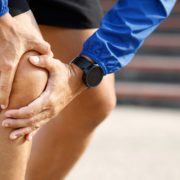When Knee Pain Doesn’t Go Away – Consider your lower back.
One of the most important things to get right when it comes to successfully resolving knee pain is to correctly identify the knee pain source.
Is your knee pain actually due to a problem in your knee? Or is the root cause of your knee pain coming from somewhere else in your body?
Rosedale, et al published a study in 2020 that revealed 43% of all isolated extremity pain was coming from the spine. What that means is that you could have nagging knee pain, and no back pain at all, and your knee pain is the result of a lower back problem. I’m not going to get into the technicalities of how this happens. Generally speaking, it’s a mechanical problem in your lower back that causes irritation to nerves or structures that impact your knee – and only your knee.
But how do you know for sure?
One of the biggest clues you’ve missed the root source of your knee pain is that it doesn’t go away after trying everything that “should” help it. Perhaps you’ve tried ice, heat, pain medication, foam rolling, strengthening, and stretching. Even physical therapy – but no matter what – your knee pain just won’t go away. It might get better for a short period, but it always comes back. If the lower back is not considered at this point, then it’s typically when knee doctors get involved. This is great if you’ve actually got a knee problem.
Knee pain that doesn’t respond to conservative treatment should be looked at further. But if your knee pain is a symptom of a problem in your lower back, and it’s missed, you risk having an unnecessary knee procedure or surgery that will only cause you more problems later.
Here’s a quick story about someone this happened to…
I spoke to a client the other day – we’ll call him “David”. He had surgery on his knee to clean out some cartilage and wear and tear from arthritis. They recommended this surgery because he had “failed” regular physical therapy treatment. Nothing else seemed to be resolving his knee pain. It was supposed to be a “quick recovery” and take his pain away because they assumed all his problems were due to arthritis. Well, three months later, Davids knee felt (and functioned) worse than pre-surgery. Now he had back pain to go along with it. To fix the new pain he was having they were recommending even more knee surgery. And now they wanted to do an MRI of his back.
How does something like this happen?
The biggest culprit is over-reliance on imaging to form a diagnosis and treatment plan. Leading you to have the wrong idea of your knee pain source.
If you’re over 50, and you get an X-ray or MRI taken of your knees, there is a 60 to 80% chance they’ll find arthritis and/or meniscus (cartilage) tears. And this will be whether you have knee pain or not. That’s because these are normal changes that occur as you age.
So if you’ve got knee pain, and your doctor wants to do some imaging, there is a very good chance they’ll find one or more of these changes in your knee. They might just blame your knee pain on it without looking at anything else. That’s exactly what happened to David. They blamed knee arthritis for his knee problem when it was actually coming from his lower back.
How do I know?
Luckily for David, he refused the second knee surgery. He went to a mechanical pain expert for diagnosis and treatment, and in 2 months both his knee and back pain were gone.
Do you have knee pain that won’t resolve with typical knee pain treatment? You must consider that it could be coming from your lower back before you undergo any kind of surgery or procedure.
If your knee pain seems to come on slowly or out of nowhere, if you have trouble pinpointing exactly where the pain is, if it moves around and changes from day to day, or if it runs up or down your leg – there is a good chance your knee pain is a symptom of a mechanical problem in your lower back and you should get it looked at.





